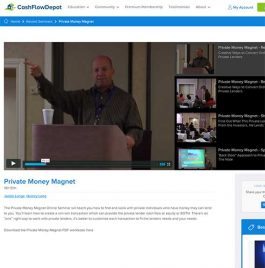Creative Financing Solutions
This title is available exclusively for CashFlowDepot Lifetime Members and is included with a membership. Learn more.
Creative Financing Solutions, by Jack Miller, will teach you how to creatively finance any real estate purchase… without using bank financing.
Why is this an important skill to learn?
When financing is easy and interest rates are low, everyone and their brother is a real estate investor. But when financing dries up or interest rates sky rocket, many of those same folks are put out of business because they rely on institutional financing to buy and sell houses.
I remember in the early 80s when it was at least 15% and 5 points for buyer to get a loan. The number of buyers who could qualify for financing was drastically reduced. Higher interest rates are predicted to come back soon. Are you prepared for the consequences?
The key is to be ready for market changes when they happen, and to find ways to keep on keeping on as an entrepreneur, whether acting as a long term investor, a wheeler-dealer, a fixer upper specialist, a buyer or a seller.
Creative Financing Solutions will teach you how!
What about non-owner-occupants (investors and speculators) who are seeking to acquire single family houses for future profit? Institutional lenders tend to deal much more harshly with them. Hard money loans are extremely expensive and usually short term. This is why it is important for investors to learn how to buy houses with Creative Financing.
What then is the solution? On the one hand we have buyers of new (or replacement) houses who must have loans in order to buy the home they want. In qualifying for the new homes, they must somehow dispose of their old houses. When money is “tight”, the sale market slows down, placing both the builders (and their lenders) and the buyers (who must first sell their existing residences in order to qualify for a loan) into a quandary.
At the same time, a portion of the market (investor/speculators) willing to absorb the surplus houses is prevented from doing so because of the same shortage of mortgage funding. The solution lies in creative financing techniques.
For the agile investor, Jack Miller’s CommonWealth Letters have a slogan: “THE GOOD NEWS IS THAT THERE IS BAD NEWS”. In so many words, what that means is that in tough times, when credit has dried up the markets, only those who have cultivated buying, selling, fixing, management, negotiating, and financing skills survive and prosper, but, when we have economic prosperity, it is possible for ANYONE to succeed.
Our markets are so vast, our citizens so affluent, our institutions so liberal, that practically every form of commercial activity has a theoretical and statistical chance to succeed. The problem with that scenario is that good times cause millions of would-be entrepreneurs to enter the market place. Success becomes a very competitive venture in which those with true ability are virtually in-distinguishable from those without the skills and knowledge normally required as a prerequisite to prosperity. Thus, our endeavors receive only average returns even though we might be able to contribute above average talent, energy, drive, capital, and imagination.
One of the principal reasons for this is that venture capital abounds in good times. Lenders woo the untried, unskilled, untalented in an effort to place the ever increasing funds deposited within their coffers. Interest rates fall as money chases borrowers. The costs of doing business are reduced correspondingly as the cost of money falls, (then they are raised again as the costs of labor and materials escalate to meet increased demand). The ebb and flow of money and production instills a cyclical rhythm into the economy; and just as Winter follows Summer, so must hard times follow the good.
In hard times, the reverse of the above holds true. Slowing economic activity causes businesses to retrench. The faint of heart drop out, others cut back on costs, materials, and labor. They slow down their payments to the banks. They with-draw surplus funds to meet current expenses. Bankers, seeing their reserves beginning to diminish, are faced with increasing loan demand from borrowers who foresee less and less certain profits with which to repay them. Interest rates are increased to meet market demand for money. Loan terms are stiffened to discount increasing risks. Money becomes tighter and tighter. Now many of us who have been waiting on the sidelines begin to see opportunities.
Those builders who need buyers, those buyers who need new homes, those speculators who are stretched thin with negative cash flows; throngs of those who knew how to prosper during times of business expansion become listless and drift during periods of contraction.
Our opportunity derives its strength and vitality from our being able to function in the market place without reliance on any financial institutions. Our competitors, who in prosperity were able to divert many opportunities to themselves, swiftly find themselves “on the ropes” when their lines of credit are withdrawn, because the key to their vigor was easy credit. Without readily available financing, they become ineffective.
Phrased another way, those who choose to depend solely upon institutional financing will always find themselves trying to make a profit in a competitive market situation. They will be “in-phase” with millions of others, condemned to mediocre success, dependent upon good times to afford them enough of a living to be able to weather the slow periods.
On the other hand, THOSE OF US WHO LEARN HOW TO PROSPER DURING HARD TIMES, WITHOUT THE HELP OF THE BANKERS, WILL BE ABLE TO OPERATE IN A NON-COMPETITIVE, PROFITABLE ENVIRONMENT.
Creative Financing Solutions will teach you how to buy, sell, and finance real estate no matter what the economy is doing. You’ll learn how to buy and sell houses without using institutional financing. You’ll never need to worry about be out of business because of lack of financing again.
You’ll learn how to devise sophisticated mortgage transactions that combine inflation and recession protection through the use of designer debt’ instruments.
TABLE OF CONTENTS
- Designer Debt Transactions
- Understanding and Using Real Estate Notes
- Increasing Security to Increase Safety of Notes
- Mortgages and Deeds of Trust
- Using Notes and Mortgages to Divide Risk and Profit
- Wrap Around Financing Concepts
- Using Wrap-Around Notes And Mortgages
- Wrap Around Note Language
- Contrasting Wrap Around Mortgages and Contracts
- Convertible Demand Wrap Around Note
- Getting Around the Due On Sale Clause
- Controlling Notes and Mortgages
- Sample Comprehensive Note Language
- Free-Form Finance Formulas
- Substitution of Collateral
- Discount Buy-Back Options
- Building Profits on Vacant Land
- Management Syndications
- Buy Now, Pay Later
- Optioning With Tax Receipts
- Horse-Trading Approaches
- Trading Ideas for Property
- House-for-House Swaps
- Pyramiding Equity and Cash Flow
- Cash-Trash-Paper Profits
- Rent-for-Equity Exchanges
- Trading a Discounted Lease for A House Equity
- Trading Assets Down to Raise Equity
- Creative Buying and Selling Applications
- Shared Appreciation Financing
- Financing Fixer-Uppers
- Buying and Selling with Nothing Down Terms
- Buying So You Can Sell
- Retired Road-Runners
- Fractional Financing
- Single Payment Note Financing
- Negotiating Zero Interest Rate Financing
- Buy High, Sell Low Profits
- Sandwich Buy-Sell Spread Profits
- Guaranteed Sales Programs
- Stocks – Real Estate – Tax Flow Combinations
- Moving Discounts From Paper to Equity
- Buying With Zero Coupon Bonds
- Leasing Tactics and Strategies
- Leasing Cash Flow Sandwich Techniques
- Leveraging Land Leases
- Leasing for the Down Payment
- Mobile Home Leasing Strategies
- Fast Write-Down Leaseholds
- Builders’ Model-Home Bailout
- Using Paper to Build Equity and Wealth
- Wraps vs Due On Sale Loan Assumption
- Using Corporate Debentures as Currency
- Changing the Shape of Payments to Change Yields
- Converting Compound into Simple Interest
- Optioning Discounted Notes
- Buying With Discounted Paper
- Take the Money and Run
- What’s It All About Alfie?
You Might Also Be Interested In…
Products Details
Pages: 93
Publisher: CashFlowDepot Books
ISBN: 9780990807667
Product Dimensions: 9 x 6 x 0.25 inches
Shipping Weight: 5.9 ounces
Topics: Financing




